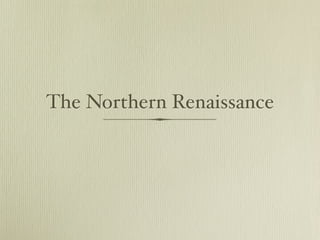Northern renaissance (13)
- 2. The Northern Renaissance Begins âĒ 1450 - Populations of N. Europe begin to grow again post bubonic plague âĒ Cities grew rapidly, merchants became wealthy enough to sponsor artists âĒ England and France under monarchies (unlike Italian city-states) who also sponsored artists and writers âĒ Northern Renaissance developed its own characteristics such as interest in realism and interest in social reform
- 3. Artistic Ideas Spread âĒ German painters - Albrecht Durer, traveled to Italy to study. Upon returning he produced woodcuts and engravings that emphasized realism. Prints portrayed classical myths, realistic landscapes. âĒ Flemish painters- Flanders - artistic center of N. Europe. Jan Van Eyck - 1st great Flemish painter. Layered oil paints to create subtle colors. Paintings had realistic details, revealed personality of subject
- 4. âĒ Flemish continued - Pieter Bruegel the Elder portrayed large numbers of people skillfully, captured scenes from everyday life (ie weddings, dances, harvests) using rich colors, vivid details, balanced use of space.
- 5. Northern Writers âĒ Christian humanists - critical of Christian Church to inspire, their focus was to reform society âĒ Desiderius Erasmus - âPraise of the Follyâ most famous work, made fun of greedy merchants, pompous priests... Believed in Christianity of the heart - not of ceremonies or rules, all people should read the Bible to improve society âĒ Thomas Moore - âUtopiaâ (ideal place) about imaginary land where greed, corruption, war were weeded out. Wrote in Latin, translated into many languages
- 6. Elizabethan Age âĒ Period when Renaissance spread to England, named after Queen Elizabeth I, well educated and talented she did much to support art and literature âĒ William Shakespeare - most famous Elizabethan writer. Used classics as inspiration for his works, revealed deep understanding of human beings, many of his plays examining human ïŽaws. Works include: Macbeth, Hamlet, Romeo & Juliet, Midsummer Nightâs Dream, The Taming of the Shrew
- 7. Printing Press Spreads Renaissance Ideas âĒ Chinese invent block printing, then movable type, but it was impractical for them. âĒ Johann Gutenberg - German craftsman, improves upon Chinese method, combines with European technology creating moveable type press. Printed a complete Bible âĒ Printing press enables production of hundreds of copies of a work quickly and cheaply
- 8. Legacy of the Renaissance âĒ Changes in the Arts âĒ Techniques from classical Greece and Rome âĒ Individuals and nature portrayed in more realistic ways âĒ Artists created secular and religious works âĒ Writers used vernacular language âĒ Arts praised individual achievement
- 9. âĒ Changes in Society âĒ Printing made information cheap and easy to obtain âĒ More books = increased desire to learn and increased literacy throughout Europe âĒ Published accounts of discoveries led to more discoveries in many areas âĒ People more likely to understand rights from reading legal proceedings âĒ People start to question political structures and religious practices









